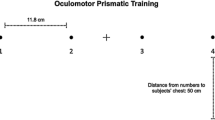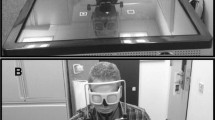Abstract
Visuomotor prismatic training has been demonstrated to be among the most effective rehabilitative techniques of spatial neglect, a neurological syndrome manifested by a number of right brain-damaged patients characterized by unawareness of the egocentric left half of the world. In the present study, we demonstrate that a novel oculomotor prismatic training procedure only consisting in a sequence of gaze shifts to visual targets, can reduce spatial neglect symptoms. Following oculomotor prismatic training, patients show a significant decrease in neglect severity in straight ahead and paper and pencil tasks. We propose that during oculomotor prismatic training, the inconsistency between the prisms-biased visual/oculomotor input and the unbiased head-on-trunk proprioceptive information relative to the straight-ahead position determines the observed aftereffects and the amelioration of spatial neglect symptoms.





Similar content being viewed by others
References
Bartolomeo P, Chokron S (2002) Orienting of attention in left unilateral neglect. Neurosci Biobehav Rev 26:217–234
Bartolomeo P, Thiebaut de Schotten M, Doricchi F (2007) Left unilateral neglect as a disconnection syndrome. Cereb Cortex 17:2479–2490. doi:10.1093/cercor/bhl181
Berberovic N, Mattingley JB (2003) Effects of prismatic adaptation on judgements of spatial extent in peripersonal and extrapersonal space. Neuropsychologia 41:493–503
Bisiach E (1999) Unilateral neglect and related disorders. In: Denes G, Pizzamiglio L (eds) Handbook of clinical and experimental neuropsychology. Psychology Press, Hove, pp 479–496
Bisiach E, Luzzatti C (1978) Unilateral neglect of representational space. Cortex 14:129–133
Bisiach E, Capitani E, Porta E (1985) Two basic properties of space representation in the brain: evidence from unilateral neglect. J Neurol Neurosurg Psychiatry 48:141–144
Bisiach E, Perani D, Vallar G, Berti A (1986) Unilateral neglect: personal and extra-personal. Neuropsychologia 24:759–767
Bisiach E, Pattini P, Rusconi ML, Ricci R, Bernardini B (1997) Unilateral neglect and space constancy during passive locomotion. Cortex 33:313–322
Bisiach E, Ricci R, Silani G, Cossa FM, Crespi MG (1999) Hypermnesia in unilateral neglect. Cortex 35:701–711
Bisiach E, Neppi-Modona M, Ricci R (2002) Space anisometry in unilateral neglect. In: Karnath HO, Milner DA, Vallar G (eds) The Cognitive and Neural Bases of Spatial Neglect. Oxford University Press, Oxford, pp 145–152
Chica AB, Thiebaut de Schotten M, Toba M, Malhotra P, Lupianez J, Bartolomeo P (2012) Attention networks and their interactions after right-hemisphere damage. Cortex 48:654–663. doi:10.1016/j.cortex.2011.01.009
Chokron S (2003) Right parietal lesions, unilateral spatial neglect, and the egocentric frame of reference. Neuroimage 20(Suppl 1):S75–S81
Colent C, Pisella L, Bernieri C, Rode G, Rossetti Y (2000) Cognitive bias induced by visuo-motor adaptation to prisms: a simulation of unilateral neglect in normal individuals? Neuroreport 11:1899–1902
Corbetta M, Shulman GL (2002) Control of goal-directed and stimulus-driven attention in the brain. Nat Rev Neurosci 3:201–215. doi:10.1038/nrn755
Crottaz-Herbette S, Fornari E, Clarke S (2014) Prismatic adaptation changes visuospatial representation in the inferior parietal lobule. J Neurosci 34:11803–11811. doi:10.1523/JNEUROSCI.3184-13.2014
Di Pellegrino G (1995) Clock-drawing in a case of left visuo-spatial neglect: a deficit of disengagement? Neuropsychologia 33:353–358
Diller L, Weinberg J (1977) Hemi-inattention in rehabilitation: the evolution of a rational remediation program. Adv Neurol 18:63–82
Facchin A, Daini R, Toraldo A (2013) Prismatic adaptation in the rehabilitation of neglect patients: does the specific procedure matter? Front Hum Neurosci 7:137. doi:10.3389/fnhum.2013.00137
Fasotti L, van Kessel M (2013) Novel insights in the rehabilitation of neglect. Front Hum Neurosci 7:780. doi:10.3389/fnhum.2013.00780
Frassinetti F, Angeli V, Meneghello F, Avanzi S, Ladavas E (2002) Long-lasting amelioration of visuospatial neglect by prism adaptation. Brain 125:608–623
Halligan PW, Marshall JC, Wade DT (1992) Left on the right: allochiria in a case of left visuo-spatial neglect. J Neurol Neurosurg Psychiatry 55:717–719
Hay JC, Pick HL, Ikeda K (1965) Visual capture produced by prism spectacles. Psychonomic Sci 2:215–216
Ishiai S, Furukawa T, Tsukagoshi H (1989) Visuospatial processes of line bisection and the mechanisms underlying unilateral spatial neglect. Brain 112(Pt 6):1485–1502
Jacquin-Courtois S, O’Shea J, Luaute J et al (2013) Rehabilitation of spatial neglect by prism adaptation: a peculiar expansion of sensorimotor after-effects to spatial cognition. Neurosci Biobehav Rev 37:594–609. doi:10.1016/j.neubiorev.2013.02.007
Kerkhoff G (2001) Spatial hemineglect in humans. Prog Neurobiol 63:1–27
Marsh EB, Hillis AE (2008) Dissociation between egocentric and allocentric visuospatial and tactile neglect in acute stroke. Cortex 44:1215–1220. doi:10.1016/j.cortex.2006.02.002
Michel C, Pisella L, Halligan PW, Luaute J, Rode G, Boisson D, Rossetti Y (2003) Simulating unilateral neglect in normals using prism adaptation: implications for theory. Neuropsychologia 41:25–39
Neppi-Modona M (1999) Influence of response modality on awareness of contralesional tactile stimuli in right brain damaged patients. Cortex 35:687–699
Pia L, Neppi-Modona M, Procopio L, Ricci R, Gindri P, Berti A (2004) Modulation of space-based and object-based neglect by perceptual parsing. Cortex 40:189–190
Rabuffetti M, Folegatti A, Spinazzola L, Ricci R, Ferrarin M, Berti A, Neppi-Modona M (2013) Long-lasting amelioration of walking trajectory in neglect after prismatic adaptation. Front Hum Neurosci 7:382. doi:10.3389/fnhum.2013.00382
Ronga I, Sarasso P, Raineri F, Duhamel JR, Becchio C, Neppi-Modona M (in press) Leftward oculomotor prismatic training induces a rightward bias in normal subjects. Experimental Brain Research. doi:10.1007/s00221-017-4934-3
Rossetti Y, Rode G, Pisella L, Farne A, Li L, Boisson D, Perenin MT (1998) Prism adaptation to a rightward optical deviation rehabilitates left hemispatial neglect. Nature 395:166–169. doi:10.1038/25988
Rusconi ML, Carelli L (2012) Long-term efficacy of prism adaptation on spatial neglect: preliminary results on different spatial components. Sci World J 2012:618528. doi:10.1100/2012/618528
Schenkenberg T, Bradford DC, Ajax ET (1980) Line bisection and unilateral visual neglect in patients with neurologic impairment. Neurology 30:509–517
Shimojo S (1987) Attention-dependent visual capture in double vision. Perception 16:445–447
van Beers RJ, Sittig AC, Gon JJ (1999) Integration of proprioceptive and visual position-information: An experimentally supported model. J Neurophysiol 81:1355–1364
van Beers RJ, Wolpert DM, Haggard P (2002) When feeling is more important than seeing in sensorimotor adaptation. Curr Biol 12:834–837
Acknowledgements
Authors are grateful to Spatial Motor and Bodily Awareness (SaMBA) Group and especially to Francesca Garbarini, Lorenzo Pia, and Raffaella Ricci for their valuable comments about the present research. IR, at the time of the experiments, was founded by a research grant by the University of Turin, Italy and, with Marco Neppi Modona, by a grant of the Italian Ministry of University and Scientific Research (MIUR), PRIN 2010ENPRYE_003.
Author information
Authors and Affiliations
Corresponding author
Ethics declarations
Conflict of interest
The authors declare that they have no conflict of interest.
Rights and permissions
About this article
Cite this article
Ronga, I., Franza, M., Sarasso, P. et al. Oculomotor prismatic training is effective in ameliorating spatial neglect: a pilot study. Exp Brain Res 235, 1771–1780 (2017). https://doi.org/10.1007/s00221-017-4923-6
Received:
Accepted:
Published:
Issue Date:
DOI: https://doi.org/10.1007/s00221-017-4923-6




